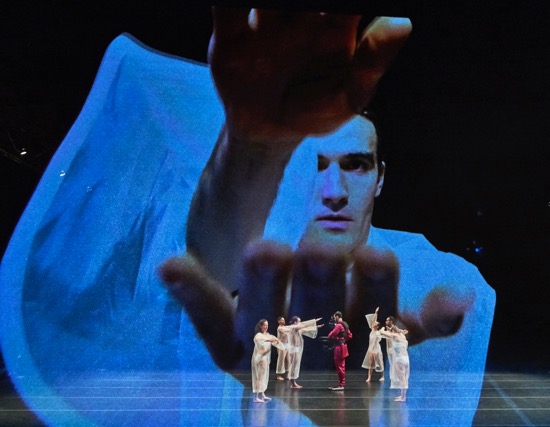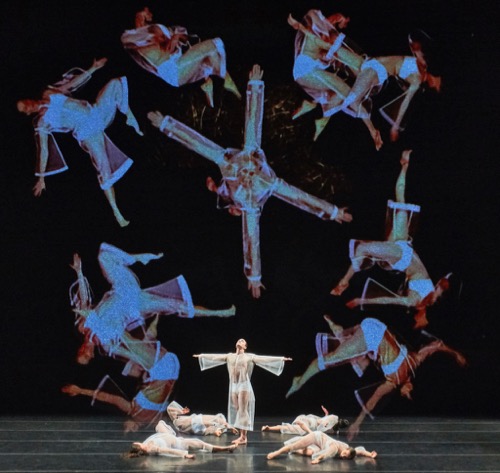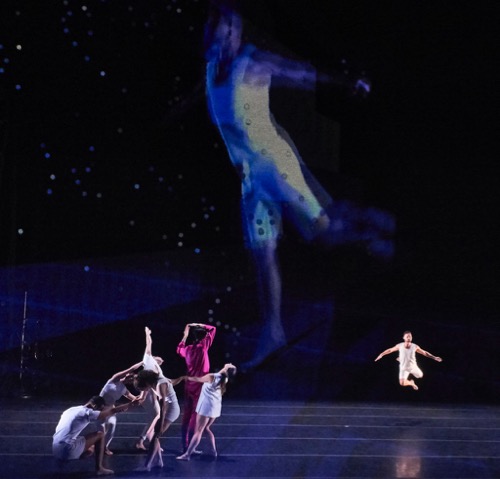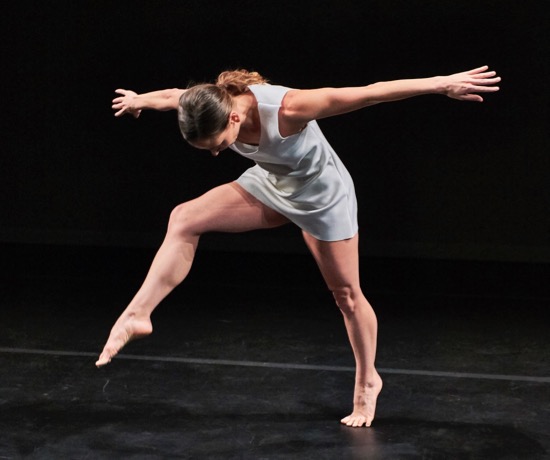Charles Atlas, Rashaun Mitchell, and Silas Riener collaborate on a video/live performance.

Part II—Tesseract O in BAM’s Next Wave Festival. Projected: Silas Riener. Onstage (L to R): Kate Jewett, David Rafael Botana, Silas Riener, Cori Kresge, Rashaun Mitchell, Eleanor Hullihan. Center: Ryan Thomas Jenkins. Photo: Robert Altman for BAM
So what do you do if you meet a dancer who’s twice your size in every way, and he (or she) reaches out a hand to you? Well you could take off the 3-D viewing glasses that you were given as you entered BAM Harvey to see Tesseract. Or you could just sit back and ponder the enigmas of the virtual stage projected onto the screen that fills the proscenium arch of the actual stage. In Part I—Tesseract, directed and edited by media artist Charles Atlas and choreographed by Rashaun Mitchell and Silas Riener, there are no living dancers.
Mitchell and Riener also dance in the film, alongside David Rafael Botana, Kristen Foote, Hiroki Ichinose, Cori Kresge, and Melissa Toogood. They all perform wonderfully well, of course, but the dancing takes second place to the swiftly shifting environment (thirteen of the names in the program belong to collaborators in the film and digital world). We’re introduced at the outset to a large white tesseract, wheeling around in a starry sky, while the electronic score by the Austrian compose-guitarist Fennesz roars. It resembles a small cube set within a bigger one, with lines connecting the two by each of their four corners, creating in the process an array of flat-topped pyramids. It twinkles in the mind.
The virtual stage has décor: flat, standing black-and-white drawings by Fraser Taylor. And Atlas draws in or opens out black panels to frame the action in different ways. This first part of Tesseract contains several recurring images that relate more to a larger idea than to one another. We first see the dancers dressed in white leotards decorated with an occasional black square or rectangle. Black makeup squares cover their eyes, and, as they’re stroking (grooming?) Toogood in closeup, you notice that their lips are pale blue. In another sequence, wearing blonde wigs, they’re tumbling about a gray space that keeps revolving, redefining where “up” is, their neutral outfits gradually flaming into iridescence.
Ichinose dances alone in a very different space; clouds covering the floor reach almost to his knees, and when he’s joined by Foote, they barely notice each other. Riener, his long hair flying, appears in a jungle of what look like pastel ropes of melting candy. Then each dancer materializes in a desert, with bare mountains in the distance. One by one, they appear—now wearing orange, sitting or kneeling, and moving around individual foot-high structures (pyramid, orb, cube, etc.) constructed of slender slats.
I haven’t meant to ignore the choreography. Mitchell and Riener danced in Merce Cunningham’s last company, and Atlas was his filmmaker-in-residence in the 1980s and early 1990s. The movement is mostly foot-lively and straight-spined, but also intriguingly responsive to changes in the strange environments that destabilize the inhabitants or make them a little crazy.

The cast of Part II—Tesseract O onstage, multiplied, and projected. Photo: Robert Altman for BAM
As the intermission winds down, the choreographers prepare us for the contrasting aesthetic proposition put forth in Part II—Tesseract O (in the program, Part I—Tesseract is followed by a square that my laptop can’t duplicate). We understand that a scrim will capture more of Atlas’s images, because stage manager Dani Prados (I assume it is he) asks for it to be lowered and double checks some of the cues in Davison Scandrett’s lighting. We watch Ryan Thomas Jenkins, centerstage, hooded and dressed in red, strap on the apparatus that supports his Steadicam. His attire is the only vivid color onstage; the dancers wear transparent white outfits over solid white underpinnings (costumes by Riener and Mitchell with Mary Jo Mecca and Yvette Helm). Silver shoes undercut his cumbersome technological equipment (a futuristic Dorothy visits Oz?), as he moves among the inhabitants of this domain. Now we focus on live dancers, garnished by Jenkins’s views of them. A few times, they attach themselves to him, following him like a white tail. Shortly before the end, their universe goes wild, and their dancing images (and parts thereof) revolve in a kaleidoscopic vision. Fennesz’s music swerves with these dissolving atmospheres.

Ryan Thomas Jenkins (in red) with Steadicam, David Rafael Botana (onstage and projected), and the cast of Part II—Tesseract O. Photo: Robert Altman
This second part of Tesseract, also with video by Atlas, begins engrossingly. Mitchell, Kresge, Botana, and Kate Jewitt anchor the four corners of the stage and begin walking in right-angled patterns, their arms lifting. Riener and Eleanor Hullihan introduce diagonals to augment and alter a fastidiously organized design built of collaborating humans. They spin off into individual statements, perhaps imitating the flying white lines projected around them like a tesseract breaking apart.
The moments that Jenkins’s actions bring to our attention are in synch with what the live dancers are doing—not just when they cluster or fall or leap. When Hullihan’s face appears on the scrim, we also see the reason: Jenkins has wandered up to her and gotten interested. With this duplication, we get to know the dancers better, whether it’s Jewitt dancing beneath her image seen from another angle, or everyone onstage watching Botana live. We see the choreography more clearly, even when the projected images get tricky; an individual, for example, can multiply into an accordioning procession, akin to that in Marcel Duchamp’s art work Nude Descending a Staircase, while distant voices sound in the music.

Eleanor Hullihan in Tesseract. Photo: Robert Altman
The dancers mostly ignore Jenkins, but they also assert their power over him. Near the end, he falls back, and they catch him and lay him out, then collaborate to pick him up and carry him to a new spot. Most of this time, Hullihan has been diligently dancing a solo. As the music starts throbbing, the stage world falls subtly apart. Everyone exits but her. Then she goes too. Then someone re-enters. But. . . .
Darkness falls. We wake up from this fragmenting dream landscape to applaud. It’s not as hallucinatory as the first, all-film part of Tesseract, but it’s more emotionally powerful—a clear negotiation between reality and a selective view of it that appears to be ephemeral. In retrospect, I think of the first part as a preface of sorts, the virtuosic camera tinkering with our perceptions of the real and the virtual, revving up our eyes.
